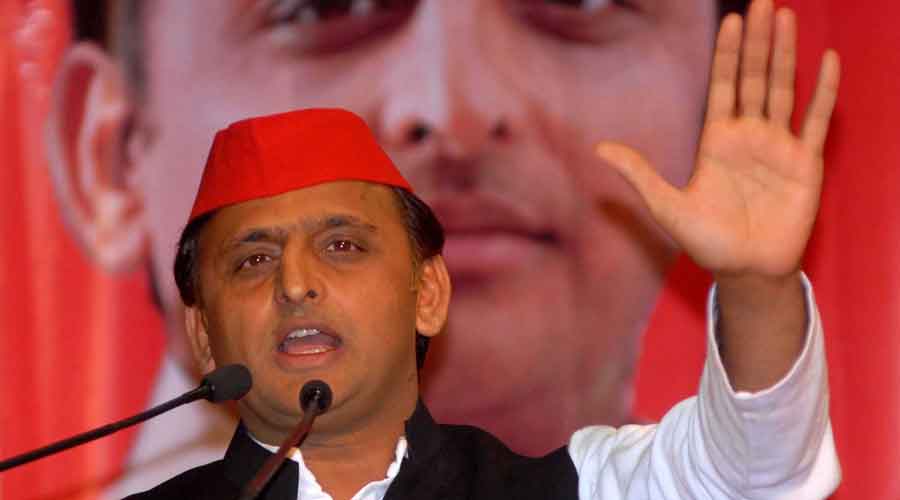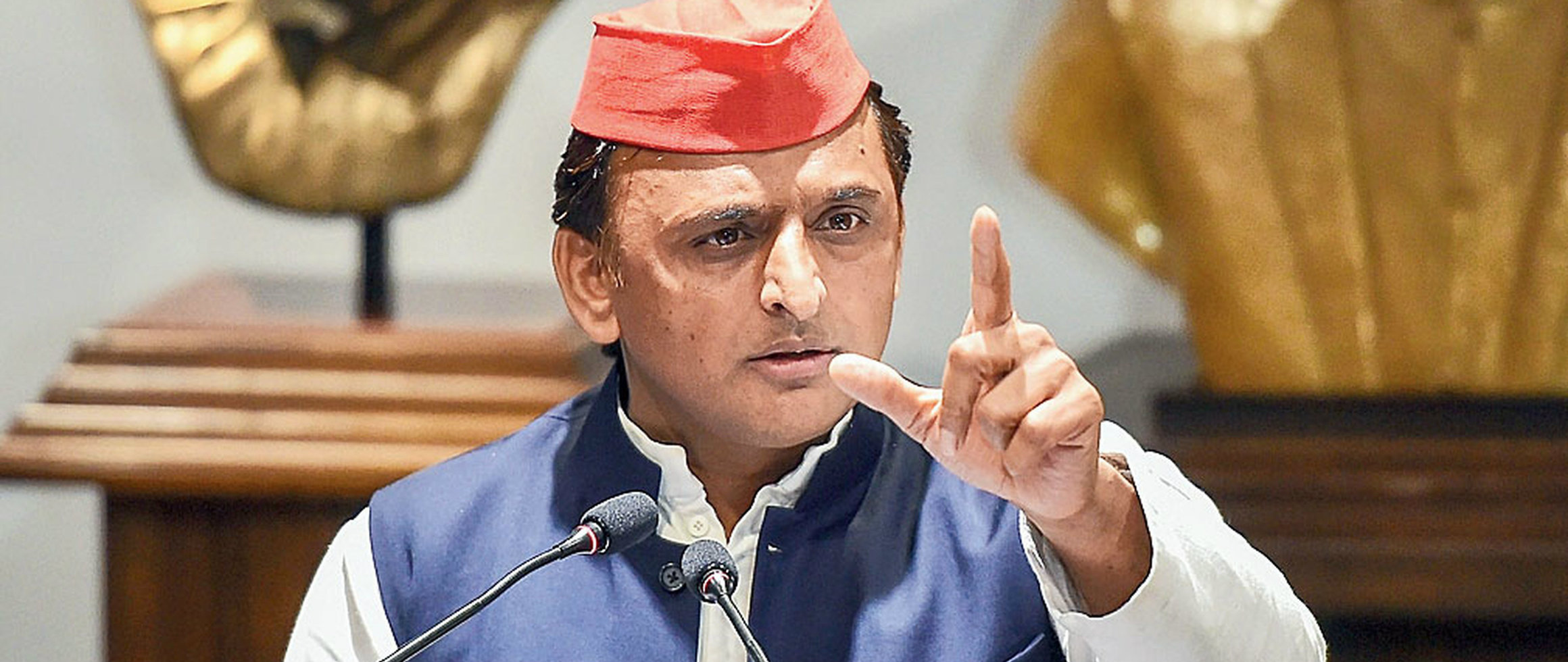Ramashankar Yadav, a retired block development officer chatting with fellow villagers at a tea shop in the Madhuban market, looks up suspiciously.
“I hope you aren’t from the godi (lapdog) media?” he asks, referring to media outlets seen widely as mouthpieces of the Narendra Modi government.
Satisfied that this correspondent doesn’t answer to that description, he opens up: “Badlav ka hawa hai (Winds of change are blowing).”
He nudges the other customers to confirm the point: “Tell the journalist.”
The customers present a rainbow of castes and communities, from the minor OBC Rajbhars and Chauhans to Dalits and Muslims. This is just the sort of social combination that Samajwadi Party president Akhilesh Yadav needs to win this election. The seventh and last phase of voting in Uttar Pradesh is scheduled on Monday.
Yadavs like Ramashankar, who have a sense of proprietorship (“hamari party”) over the Samajwadis, are keen to get the smaller castes to rally behind the “cycle” to help it ride to power in Lucknow.
In the 2014 and 2019 general elections and the 2017 Assembly polls, the BJP had brought almost all non-Yadav OBCs and non-Jatav Dalits under its umbrella to build a virtually unbeatable coalition.
Akhilesh is trying to win over segments of these communities, and the extent of his success in the effort may decide his fate when the results are declared on March 10.
Maganlal Rajbhar, sitting in front of Ramashankar, says “BDO sahib” is right.
He adds that everybody — farmer or youth — is suffering under joblessness and the menace of stray cattle, blamed widely on the state government’s crackdown on cattle trade and transport.
“Another big issue is the dilution of reservation by the BJP,” Rajbhar says, referring to the 10 per cent quota for the poor among the upper castes that the Modi government implemented ahead of the 2019 Lok Sabha polls.
“People with 13 bighas of land are getting reservation,” interjects Keshav, who belongs to the Jatav Dalit community, traditional supporters of the Bahujan Samaj Party (BSP). “Give me 13 bighas and end my reservation,” he declares.
While the Muslims in the gathering listen quietly — a dominant trend in this election, driven by the fear that any whiff of polarisation might help the BJP — Rajbhar raises the subject of the Modi government’s failure to sub-categorise OBC reservation.
Such sub-categorisation — a BJP promise — is meant to ensure a more equitable share of the OBC quota benefits, of which the lion’s share now goes to dominant castes like the Yadavs and Patels/ Kurmis at the expense of the minor OBCs. The Modi government had formed a committee for the purpose in 2017 but its report is still pending amid suggestions that the BJP is wary of annoying its Patel/ Kurmi supporters.
Asked about this, Ramashankar displays a sense of discomfort. “There can be distribution (of the benefits) only if reservation survives at all,” he says somewhat evasively.
The Samajwadis and their allies accuse the BJP of looking to scrap reservations.
While the minor OBCs and Muslims sipping tea with Ramashankar indicate they would vote for the Samajwadis, the voting trend among these communities tends to change from constituency to constituency and region to region.
With Om Prakash Rajbhar of the Suheldev Samaj Party dumping the BJP for the Samajwadis, most Rajbhars, who matter in around 20-30 constituencies in eastern Uttar Pradesh, appear inclined to back the Samajwadi-led alliance. But not all.
At his small tea and snacks shop on the Ghazipur-Mau road, Shankar Rajbhar looks around carefully before saying that a Samajwadi return to power would revive “gundai” (hooliganism).
“The Yadavs here have already resorted to lumpen behaviour. They tie the Samajwadi flag to the horns of buffaloes and chant slogans in favour of Akhilesh,” Shankar says.
Shankar and his wife cite the welfare schemes implemented by the Modi and Yogi Adityanath governments and say they will vote for the BJP. “Om Prakash is a party-hopper,” Shankar says dismissively.
His customer Dilip Kumar Vishwakarma, also a minor OBC who works in the Ghazipur office of the central government’s water resources department, nods: “Uncle is right.”
Vishwakarma, however, adds that the job crisis may encourage many to cross caste barriers and vote for the Samajwadis, for Akhilesh has promised to fill the vacant government posts.
Many voters from the minor castes do talk about the price rise and unemployment under BJP rule, but at the same time complain about the “undue privileges” enjoyed by Yadavs and Muslims whenever the Samajwadis come to power.
It was this perceived bias during Akhilesh’s 2012-17 tenure that pushed most of the minor castes into the BJP’s arms.
“The Yadavs are already going mad,” said Mithailal, a Dalit in rural Mirzapur, referring to the barricades and chairs being smashed at Akhilesh’s rallies in displays of supporter frenzy.
The minor and marginalised castes appear to have emerged as key players this election. On the ground one can sense a churning among them, fuelled by a desire for enhanced representation and a share in the power pie. They are no longer ready to be mere flag-bearers for the BJP or the Samajwadis — even for the BSP, which has turned a marginal player this election.
This unrest has given rise to many regional and sub-regional outfits that claim to represent the aspirations of specific castes like the Rajbhars, Nishads, Nonia Chauhans, Binds and Mauryas.
Many of these smaller castes have been demanding Scheduled Castes status, saying they cannot compete with the well-off OBCs like Yadavs and Patels/ Kurmis. The Dalits are opposing the demand, fearful of their space getting crowded.
Against this backdrop, the smaller parties operating as the voices of these marginalised sections have been negotiating, bargaining and tying up with the main players.
In Uttar Pradesh, where OBC and Dalit politics has ruled for three decades, Adityanath’s elevation marks the return of political dominance by the upper castes — specifically by the chief minister’s caste of Thakurs.
The Samajwadis and their allies are trying to woo the minor OBCs by citing the return of “Thakurvaad” under Adityanath. However, this seems counterbalanced in the minds of many minor caste voters by the fear of “Yadav raj” if Akhilesh comes to power.
Partly to dispel such fears, Akhilesh has tied up with several sub-regional parties like Suheldev Samaj and Mahan Dal, and given tickets to a large number of candidates from the minor castes.
The BJP too has an ally in Apna Dal, which draws support from OBC Patels/ Kurmis and the Nishad Party, which claims to represent the community of Nishads or boatmen.
Which way the minor castes turn can decide this election.











